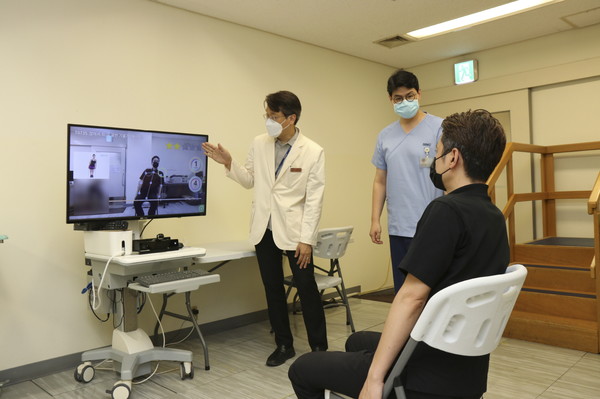Korean researchers said they developed a home-based exercise program (HEP) with an augmented reality (AR) system to improve balance in patients with stroke.
Many stroke patients have difficulties in their daily lives due to impaired balance, finding it hard to walk properly. They also become easily exposed to falling.

Although rehabilitation programs are available to prevent falling, 73 percent of stroke patients suffer from falling within one year after the stroke.
The research team, led by Professor Chang Won-Hyuk of rehabilitation medicine at Samsung Medical Center, said on Monday that the hospital introduced a HEP with AR to provide effective rehab to stroke patients.
The AR-based HEP uses 3-D virtual images that overlap with the real images and backgrounds. The program helps patients to practice various movements in the background of their homes.
The research team divided 68 stroke patients into the existing HEP group and the AR-based HEP group. The existing HEP group underwent written and pictorial HEP.
The AR-based HEP group had AR facilities installed at home. When the user stands in front of the installed monitor, the sensor recognizes the patient’s body, and the screen displays the patient’s movement. The movements were converted to scores, and only when 80 percent or more was achieved, the user could move on to the next level.
The patient’s rehab exercise scores in each session were delivered to professional therapists. The therapists could provide appropriate feedback through weekly telephone consultations based on these records.
The patients evaluated the HEP three times – before and immediately after the use of the program and one month after the use.
The evaluation included not only balance but fear of falling and depressed feelings.
Both groups improved in balance and psychological evaluation outcomes after the HEP.
In balance and quality of life, the AR-based HEP group scored 1 or 2 points higher than the existing HEP group.
The two groups did not show much difference in depressed feelings.
However, the change in fear of falling was significantly greater in the AR-based HEP group than in the control group.
The conventional HEP group’s score in fear of falling was similar before and one month after the HEP – 21.7 and 20.8. In contrast, the AR-based HEP group’s score fell from 25 to 19.3.
The research team said that the AR-based HEP did not report any falling, demonstrating safety.
However, one patient with vertebral artery dissection in the AR-based HEP group had to discontinue participation due to dizziness while using the program.
Thus, patients need to consult with a professional before using the AR-based HEP.
“By combining AR in the rehabilitation exercise program, which has not progressed much so far, we can carry out customized rehab treatment at home,” Chang said.
The study was published in the latest issue of Disability and Rehabilitation.

